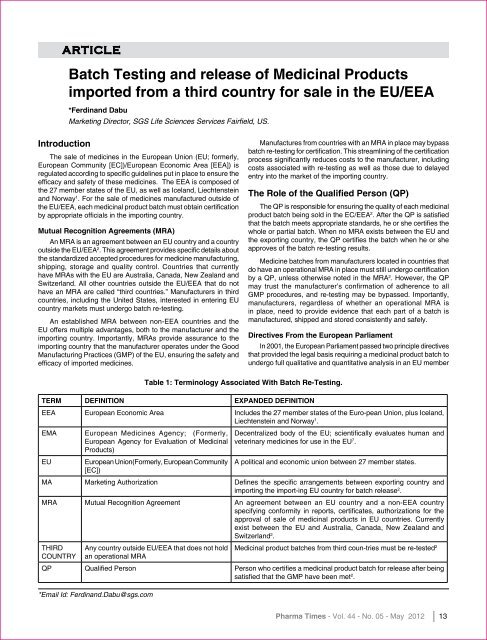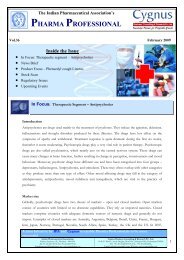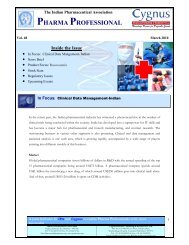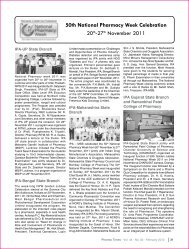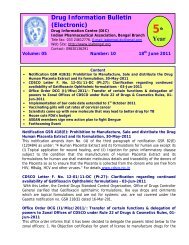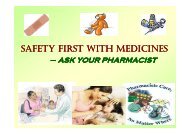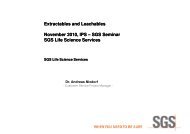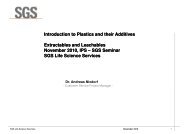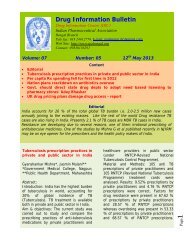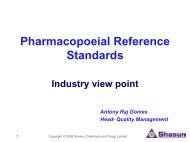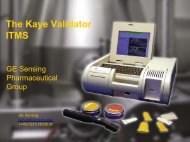batch Testing and release of Medicinal Products imported from a ...
batch Testing and release of Medicinal Products imported from a ...
batch Testing and release of Medicinal Products imported from a ...
You also want an ePaper? Increase the reach of your titles
YUMPU automatically turns print PDFs into web optimized ePapers that Google loves.
Article<br />
<strong>batch</strong> testing <strong>and</strong> <strong>release</strong> <strong>of</strong> medicinal products<br />
<strong>imported</strong> <strong>from</strong> a third country for sale in the EU/EEA<br />
*Ferdin<strong>and</strong> Dabu<br />
Marketing Director, SGS Life Sciences Services Fairfield, US.<br />
Introduction<br />
The sale <strong>of</strong> medicines in the European Union (EU; formerly,<br />
European Community [EC])/European Economic Area [EEA]) is<br />
regulated according to specific guidelines put in place to ensure the<br />
efficacy <strong>and</strong> safety <strong>of</strong> these medicines. The EEA is composed <strong>of</strong><br />
the 27 member states <strong>of</strong> the EU, as well as Icel<strong>and</strong>, Liechtenstein<br />
<strong>and</strong> Norway 1 . For the sale <strong>of</strong> medicines manufactured outside <strong>of</strong><br />
the EU/EEA, each medicinal product <strong>batch</strong> must obtain certification<br />
by appropriate <strong>of</strong>ficials in the importing country.<br />
Mutual Recognition Agreements (Mra)<br />
An MRA is an agreement between an EU country <strong>and</strong> a country<br />
outside the EU/EEA 2 . This agreement provides specific details about<br />
the st<strong>and</strong>ardized accepted procedures for medicine manufacturing,<br />
shipping, storage <strong>and</strong> quality control. Countries that currently<br />
have MRAs with the EU are Australia, Canada, New Zeal<strong>and</strong> <strong>and</strong><br />
Switzerl<strong>and</strong>. All other countries outside the EU/EEA that do not<br />
have an MRA are called “third countries.” Manufacturers in third<br />
countries, including the United States, interested in entering EU<br />
country markets must undergo <strong>batch</strong> re-testing.<br />
An established MRA between non-EEA countries <strong>and</strong> the<br />
EU <strong>of</strong>fers multiple advantages, both to the manufacturer <strong>and</strong> the<br />
importing country. Importantly, MRAs provide assurance to the<br />
importing country that the manufacturer operates under the Good<br />
Manufacturing Practices (GMP) <strong>of</strong> the EU, ensuring the safety <strong>and</strong><br />
efficacy <strong>of</strong> <strong>imported</strong> medicines.<br />
Manufactures <strong>from</strong> countries with an MRA in place may bypass<br />
<strong>batch</strong> re-testing for certification. This streamlining <strong>of</strong> the certification<br />
process significantly reduces costs to the manufacturer, including<br />
costs associated with re-testing as well as those due to delayed<br />
entry into the market <strong>of</strong> the importing country.<br />
The Role <strong>of</strong> the Qualified Person (Qp)<br />
The QP is responsible for ensuring the quality <strong>of</strong> each medicinal<br />
product <strong>batch</strong> being sold in the EC/EEA 2 . After the QP is satisfied<br />
that the <strong>batch</strong> meets appropriate st<strong>and</strong>ards, he or she certifies the<br />
whole or partial <strong>batch</strong>. When no MRA exists between the EU <strong>and</strong><br />
the exporting country, the QP certifies the <strong>batch</strong> when he or she<br />
approves <strong>of</strong> the <strong>batch</strong> re-testing results.<br />
Medicine <strong>batch</strong>es <strong>from</strong> manufacturers located in countries that<br />
do have an operational MRA in place must still undergo certification<br />
by a QP, unless otherwise noted in the MRA 2 . However, the QP<br />
may trust the manufacturer’s confirmation <strong>of</strong> adherence to all<br />
GMP procedures, <strong>and</strong> re-testing may be bypassed. Importantly,<br />
manufacturers, regardless <strong>of</strong> whether an operational MRA is<br />
in place, need to provide evidence that each part <strong>of</strong> a <strong>batch</strong> is<br />
manufactured, shipped <strong>and</strong> stored consistently <strong>and</strong> safely.<br />
Directives From the European Parliament<br />
In 2001, the European Parliament passed two principle directives<br />
that provided the legal basis requiring a medicinal product <strong>batch</strong> to<br />
undergo full qualitative <strong>and</strong> quantitative analysis in an EU member<br />
*Email Id: Ferdin<strong>and</strong>.Dabu@sgs.com<br />
Table 1: Terminology Associated With Batch Re-<strong>Testing</strong>.<br />
TERM DEFINITION EXPANDED DEFINITION<br />
EEA European Economic Area Includes the 27 member states <strong>of</strong> the Euro-pean Union, plus Icel<strong>and</strong>,<br />
Liechtenstein <strong>and</strong> Norway 1 .<br />
EMA<br />
EU<br />
European Medicines Agency; (Formerly,<br />
European Agency for Evaluation <strong>of</strong> <strong>Medicinal</strong><br />
<strong>Products</strong>)<br />
European Union(Formerly, European Community<br />
[EC])<br />
Decentralized body <strong>of</strong> the EU; scientifically evaluates human <strong>and</strong><br />
veterinary medicines for use in the EU 7 .<br />
A political <strong>and</strong> economic union between 27 member states.<br />
MA Marketing Authorization Defines the specific arrangements between exporting country <strong>and</strong><br />
importing the import-ing EU country for <strong>batch</strong> <strong>release</strong> 2 .<br />
MRA Mutual Recognition Agreement An agreement between an EU country <strong>and</strong> a non-EEA country<br />
specifying conformity in reports, certificates, authorizations for the<br />
approval <strong>of</strong> sale <strong>of</strong> medicinal products in EU countries. Currently<br />
exist between the EU <strong>and</strong> Australia, Canada, New Zeal<strong>and</strong> <strong>and</strong><br />
Switzerl<strong>and</strong> 2 .<br />
THIRD<br />
COUNTRY<br />
Any country outside EU/EEA that does not hold<br />
an operational MRA<br />
<strong>Medicinal</strong> product <strong>batch</strong>es <strong>from</strong> third coun-tries must be re-tested 2<br />
QP Qualified Person Person who certifies a medicinal product <strong>batch</strong> for <strong>release</strong> after being<br />
satisfied that the GMP have been met 2 .<br />
Pharma Times - Vol. 44 - No. 05 - May 2012 13
Figure 1: Batch Re-<strong>Testing</strong> Process.<br />
state. Directive 2001/83/EC specifically established this testing for<br />
<strong>batch</strong>es <strong>of</strong> medicines for human use 3 , while Directive 2001/82/EC<br />
did so for medicines for veterinary use 4 . These directives require the<br />
certification <strong>of</strong> each medicinal product <strong>batch</strong> by a QP. Additionally,<br />
the EU member states must ensure that the QP is performing his<br />
or her job adequately by ensuring proper administrative oversight.<br />
Additional laws under Directive 2003/94/EC were approved in 2003<br />
<strong>and</strong> established that contract laboratories operating in accordance<br />
with Directive 2001/83/EC may perform this <strong>batch</strong> re-testing 5 .<br />
More details established by Annex 16<br />
While the directives establish the need for qualitative <strong>and</strong><br />
quantitative testing <strong>and</strong> QP certification, they do not provide specific<br />
details about these regulations. Annex 16 to the “EU Guide to<br />
Good Manufacturing Practice” legally requires a QP <strong>of</strong> the importer<br />
to certify the finished medicinal product before the <strong>batch</strong> may be<br />
<strong>release</strong>d for sale in EU/EEA countries 7 . This annex also allows for<br />
the QP <strong>of</strong> one country in the EU/EEA to accept certification <strong>of</strong> a<br />
QP <strong>from</strong> another EU/EEA country, which may further streamline<br />
the process.<br />
Annex 16 legally requires medicines <strong>from</strong> non-EC/EEA<br />
countries to undergo <strong>batch</strong> testing, with the exception <strong>of</strong> countries<br />
that have an MRA with the EU 4 . If a medicinal product <strong>batch</strong> is<br />
<strong>imported</strong> in separate parts, either conditions <strong>of</strong> consistency between<br />
the parts need to be proven, or each part <strong>of</strong> the <strong>batch</strong> must be<br />
re-tested individually. These conditions include demonstrating<br />
that individual parts belong to the same <strong>batch</strong>; the sample tested<br />
is representative <strong>of</strong> the entire <strong>batch</strong>; <strong>and</strong> that each part has been<br />
manufactured, shipped <strong>and</strong> stored in a manner equivalent to that<br />
<strong>of</strong> the sample tested.<br />
EU Laws Guide Local Legislation<br />
For importation <strong>of</strong> medicine <strong>batch</strong>es into EC/EEA member<br />
countries, the regulations <strong>of</strong> Annex 16 <strong>and</strong> the two directives require<br />
each country to establish local legislation stipulating that these<br />
procedures be put into practice.<br />
Conclusion<br />
When <strong>batch</strong> re-testing is required, a skilled contract laboratory<br />
can h<strong>and</strong>le all <strong>of</strong> the quality control testing <strong>and</strong> validation necessary<br />
to <strong>release</strong> a medicinal <strong>batch</strong> for sale in the European Union. SGS<br />
Figure 2: Re-<strong>Testing</strong> <strong>of</strong> subsequent Partial Batches<br />
Life Science Services facilities located in Frankfurt (Taunusstein)<br />
<strong>and</strong> Berlin, Germany; Brussels (Wavre), Belgium; <strong>and</strong> Paris<br />
(Clichy), France are each qualified to conduct the re-testing<br />
required for <strong>batch</strong> <strong>release</strong>. Each facility conducts a diverse array <strong>of</strong><br />
pharmaceutical testing, including analytical chemistry, microbiology,<br />
method development <strong>and</strong> validation. Due to their exclusive role in<br />
pharmaceutical testing <strong>and</strong> not medicine manufacturing, SGS Life<br />
Science Services functions as a trusted <strong>and</strong> independent partner.<br />
References<br />
1. “European Economic Area (EEA).” Europa, European Union<br />
External Action. http://eeas.europa.eu/eea/. Accessed May 29,<br />
2011.<br />
2. “Mutual Recognition Agreements between the EU <strong>and</strong> the<br />
respective Parties Australia, Canada, New Zeal<strong>and</strong>, <strong>and</strong><br />
Switzerl<strong>and</strong>: Guide to the MRAs in Operation.” Final, Version<br />
5 May 2003. Doc. Ref: EMEA/MRA/22/03 Final. Specifically,<br />
I-3; II-3.2; <strong>and</strong> Appendices A <strong>and</strong> B.)<br />
3. “Directive 2001/83/EC <strong>of</strong> the European Parliament <strong>and</strong> <strong>of</strong> the<br />
Council <strong>of</strong> 6 November 2001 on the Community Code Relating<br />
to <strong>Medicinal</strong> <strong>Products</strong> for Human Use”. Official Journal L – 311,<br />
28/11/2004, p. 67 – 128. Specifically, Article 51 (1b) <strong>and</strong> Article<br />
51 (2).<br />
4. “Directive 2001/82/EC <strong>of</strong> the European Parliament <strong>and</strong> <strong>of</strong> the<br />
Council <strong>of</strong> 6 November 2001 on the Community Code Relating<br />
to Veterinary <strong>Medicinal</strong> <strong>Products</strong>.” Official Journal L -311,<br />
28/11/2004, p. 1 – 66. Specifically, Article 55 (1) <strong>and</strong> (2).<br />
5. “Commission Directive 2003/94/EC <strong>of</strong> 8 October 2003. Laying<br />
Down the Principles <strong>and</strong> Guidelines <strong>of</strong> Good Manufacturing<br />
Practice in Respect <strong>of</strong> <strong>Medicinal</strong> <strong>Products</strong> for Human Use.”<br />
Specifically, Article 11 (2). Official Journal L262, p. 22 – 26.<br />
6. Annex 16 to the EU Guide to Good Manufacturing Practice.<br />
Version 8 (Final). “Certification by a Qualified Person <strong>and</strong><br />
Batch Release.” European Commission; Enterprise Directorate-<br />
General; July 2001; p. 1-10. Specifically, sections 6 <strong>and</strong> 7.<br />
7. “What We Do;” European Medicines Agency (EMEA). http://<br />
www.ema.europa.eu/ema/index.jsp?curl=pages/about_us/<br />
general/general_content_000091.jsp&murl=menus/about_us/<br />
about_us.jsp&mid=WC0b01ac0580028a42. Accessed May<br />
28, 2011.<br />
Pharma Times - Vol. 44 - No. 05 - May 2012 14


